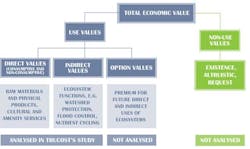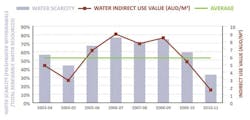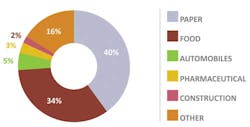While there remains a belief that water should be free, in reality it's an expensive business getting it from source to tap. Australia's Yarra Valley Water decided to estimate the true value of water being supplied in Melbourne. As WWi finds out from a resulting White Paper, it is hoped the findings will help deliver sustainable and economically efficient water to the region.
Australia is one of many countries where vulnerability to drought and the impact of population growth on water demand and the environment make changes in water management critical. The Intergovernmental Panel on Climate Change (IPCC) has identified ecosystems, water security and coastal communities in Australia as particularly vulnerable to climate change. Climate change could cause up to a 20% change in runoff in the catchments supplying Melbourne by 2030, with changes in rainfall and higher evaporation resulting in less water for dams and catchments. Runoff in the region could fall by up to 50% by 2070.
The Government is investing AUD12.9 billion over 10 years in a climate change adaptation programme as part of "Water for the Future", an initiative to better balance the water needs of communities, farmers and the environment and help secure water supplies. The Water Act 2007 establishes water entitlements to protect or restore environmental assets.
Report Findings
Environmental economics firm Trucost, who were commissioned by Yarra Valley to conduct the analysis, found that the indirect use value of water to Melbourne is significant, averaging AUD5.85 per m3 between 2003-04 and 2010-11. This translates into a natural capital asset value of about AUD2 billion. The indirect use value of water in a year when it was relatively scarce was five times higher than in a year when supply and demand were more balanced.
The un-priced indirect use value of water is far higher than its direct use value, based on current market prices for residential users (AUD1.90 per m3). Households would be willing to pay AUD1.89 to avoid reducing water availability by one m3. The gap between the indirect use value of water and willingness to pay is even wider for industrial users. They would be willing to pay a weighted average value of AUD1.25 for each additional m3, far less than its indirect use value.
Indirect Use Values
The value of water to Melbourne ranges from AUD1.66/m3 in 2010-11, when water was relatively abundant, to AUD8.97/m3 in the most water-scarce year analysed. The hydrological function has the highest indirect use value of the ecosystem functions analysed (AUD4.85/m3). Of the hydrological functions analysed, groundwater recharge has a far more significant value than freshwater replenishment. So why is groundwater recharge value so high?
Groundwater recharge accounts for 73% of the total indirect use value of water (AUD5.85/m3). The inland water resource system of a territory is composed of surface water, groundwater and soil water, and the flows between them. Groundwater is particularly important to maintaining significant wetlands and other ecosystem services in the region in which Melbourne sources its water, where overall extraction levels of groundwater are low compared to the average for Australia.
Groundwater extraction in the catchment area from which Yarra Valley Water sources supplies is equivalent to 1% of renewable surface water, compared with 14% nationally. This low ratio suggests that the volume of groundwater is relatively small in the region. Hence, the groundwater recharge value for one cubic metre of water is high compared to other indirect use values.
Calculating Indirect Use Values
The three metropolitan retailers – Yarra Valley Water, City West Water and South East Water – withdrew 343.6 million m3 of water to supply customers in Melbourne in 2010-2011.At AUD5.85/m3, the value of water to Melbourne translates into the consumption of a natural asset valued at more than AUD2 billion. This is far higher than the net value of revenue from urban water sales to the retailers (AUD1.2 billion in 2010-11).57 At 1.66 per m3, the ecosystem function value of water used in Melbourne in 2010-11 would amount to more than AUD570 million. If scarcity levels had been as high as in 2006-07, water assets would be valued at more than AUD3 billion. Planning could take account of the range in valuations and weight forecasts of external costs based on variability in water availability and probability functions. This could take account of the materiality of economic, environmental and social costs from water shortages. The costs of averting shortages are likely to be outweighed by the high costs of inaction.
Commercial and Industrial Uses
More than three-quarters of the water supplied by Yarra Valley Water to commercial users goes to industrial/manufacturing sectors, such as textiles and plastics producers. Trucost focused on the five sectors that use the most commercial water supplied by Yarra Valley Water: paper, food, automobiles, pharmaceutical and construction.
The study estimates the direct use value of water used by industrial/manufacturing customers based on the price charged for industrial use and an estimate of a business's WTP per kilolitre increase in water provided by Yarra Valley Water.
Industrial/manufacturing water pricing for Yarra Valley Water supplies is around 1.91 AUD/m3. On the topic of the willingness to pay, the five sectors analysed would be willing to pay the weighted average value of AUD1.25 per m3. Estimates of the marginal value of water across the sectors range from AUD0.16 per m3 for paper to AUD5.11/m3 for automobiles. The marginal values reflect willingness to pay for each additional cubic meter of water.
Findings indicate that water is undervalued as a resource, particularly by manufacturers. Some sectors value water more highly than others, based on the marginal productivity of the natural resource as an input.
The automotive and construction sectors value water far more highly than do the paper and food industries, despite their high dependency on water as a key input.
Calculating Non-consumptive Direct Use Values
The non-consumptive direct use value of water amounts to an estimated AUD126 million. This is based on the value of access to waterways and recreational sites around Melbourne, where some 33 million visits are made annually.
Direct non-consumptive values estimate the value of water's contribution to human wellbeing, without impacting the availability of water. This analysis focuses on the value of water for recreational fishing in Melbourne and its supply catchments. Academic studies on the value of recreational activities in the region focus on fishing, therefore this is taken as a proxy for all water-related activities.
This analysis is based on a study of fishing and recreational activity in Western Australia to help policy makers assess all of the financial implication of degrading fish stocks. Empirical data for the study came from a National Survey of Recreational Fishing 2000/2001, commissioned by the Department of Fisheries.
The study also calculates the total annual value of access to recreational fishing as the average site access value multiplied by the number of fishing days in a region.
These findings were used to evaluate the recreation activities and fishing for Melbourne. Approximately 33 million visits are made to waterways and recreational sites situated in the region. At AUD3.81 per visit, the total annual access value is estimated at AUD125.8 million. The analysis does not distinguish between people visiting sites for fishing and other recreational activities. Research suggests that individuals value the experience of being in the natural environment more than the physical result of fishing.
Conclusion
This White Paper shows that the total economic value of water to society is higher than the market price of water that is used in financial decision-making to allocate or use resources. The value of water is high (approximately AUD5.85/m3).
Given the high level of water scarcity in Melbourne, decisions on water use should consider the total economic value of water. The water industry and policy makers can consider environmental valuations in decision-making to deliver water efficiency and more effective resource allocations that help address water scarcity without impacting wellbeing or industry revenues.
Valuations that take account of fluctuations in water availability over time can inform investment decisions and be used to communicate challenges in balancing financial outcomes with environmental and social costs. Policies on abstraction, subsidies, environmental levies and water pricing can consider the indirect use values of water to strengthen management of natural capital. Continuous monitoring of water scarcity and related indirect use values could be used to inform planning.
Trucost highlighted five questions in the White Paper which they said could help frame future work to understand and apply environmental valuations:
1. How do water utilities assess whether financial benefits exceed costs when externalities are taken into account?
2. How can the water industry, regulators and researchers develop a common approach to economic valuations of water in Victoria? What other options might deliver similar outcomes?
3. What are the barriers to developing a framework for consistent ecosystem valuations by water catchment users in Victoria, and how can they be addressed?
4. How can stakeholders strengthen their consideration of impacts and dependence on functions identified as most material in this study, such as groundwater recharge?
5. How could environmental valuations support more efficient and sustainable resource allocations? How can water valuations be used to help allocate resources to maximise social welfare in the long term?
Author's note: This article is based on the White Paper entitled: "Valuing water to drive more effective decisions". Yarra Valley Water engaged environmental economics experts Trucost to undertake research to estimate the 'value of water' and develop the White Paper Valuing water to drive more effective decisions for discussion in Victoria, Australia and internationally. For more information and to receive a copy of the White Paper, please visit: http://bit.ly/12Pc2Np.






